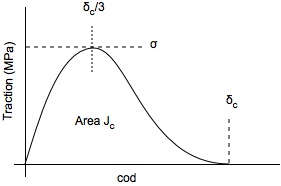Difference between revisions of "Cubic Traction Law"
| Line 39: | Line 39: | ||
| ([[Common Traction Law Properties|other]]) || Properties common to all traction laws || varies || varies | | ([[Common Traction Law Properties|other]]) || Properties common to all traction laws || varies || varies | ||
|} | |} | ||
== Traction Law Properties == | |||
<references/> | |||
Revision as of 11:01, 22 December 2020
The Traction Law
This traction law assumes use a cubic cohesive law for traction as a function of crack opening displacement (COD). The four parameters in the cubic functino of found by requiring zero traction at δ=0 and at δ=δc, peak stress at σ, and zero slope at δ=δc. Note that the peek stress is always at δc/3. This traction law was first proposed by Needleman.[1] It has a convenient smooth shape for numerical calculations and the zero slope at δc may be desirable. There is no physical basis to claim it is more realistic than other traction laws. The resulting function is
[math]\displaystyle{ \sigma = {27\over 4}\sigma_{max} {\delta\over\delta_c}\left(1-{\delta\over\delta_c}\right)^2 }[/math]
There are separate traction laws for opening displacement (mode I) and sliding displacement (mode II).
The toughness of this traction law is the area under the curve or:
[math]\displaystyle{ J_c = {9\over 16} \sigma\delta_c }[/math]
When creating this traction law, you have to enter exactly two of these failure properties for both mode I and mode II (i.e., two of JIc, σI, and δIc and two of JIIc, σII, and δIIc). Whichever property is not specified will be calculated from the two provided properties using one of the following relations:
[math]\displaystyle{ \delta_c = {16J_c\over 9000\sigma}, \qquad \sigma = {16J_c\over 9000\delta_c}, \qquad {\rm or} \qquad J_c = {9000\over 16}\sigma\delta_c }[/math]
These relations assume JIc in J/m2, σ in pressure units, and δc in length units.
Besides specifying area and toughness properties, the cubic traction law has no other adjustable parameters. The initial slope and peak location are given once the area is specified. Thus unlike most other traction laws, this law has fewer parameters, which can be helpful when studying role of traction laws on failure simulations.
Failure
The failure criterion under pure more or possible mixed-mode conditions is identical to the one used in the triangular traction law.
Traction Law Properties
This traction law only needs the common traction law properties
| Property | Description | Units | Default |
|---|---|---|---|
| (other) | Properties common to all traction laws | varies | varies |
Traction Law Properties
- ↑ A. Needleman, "A continuum model for void nucleation by inclusion debonding," J. Appl. Mech., 54, 525–531. (1987)
